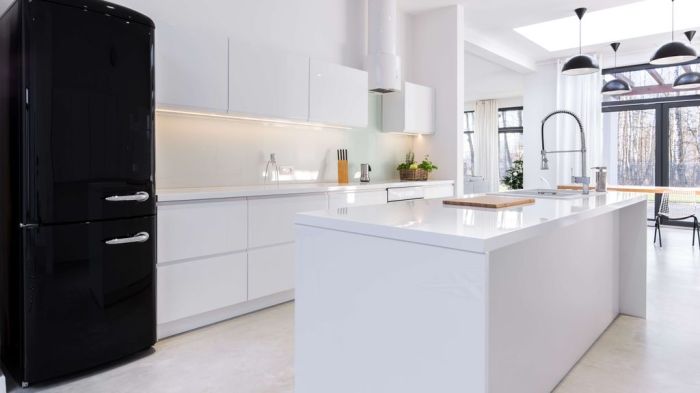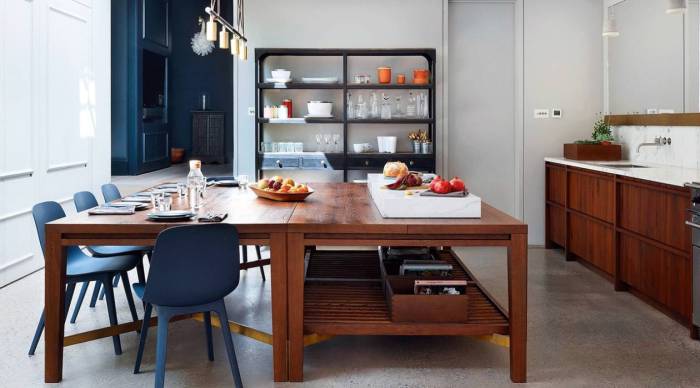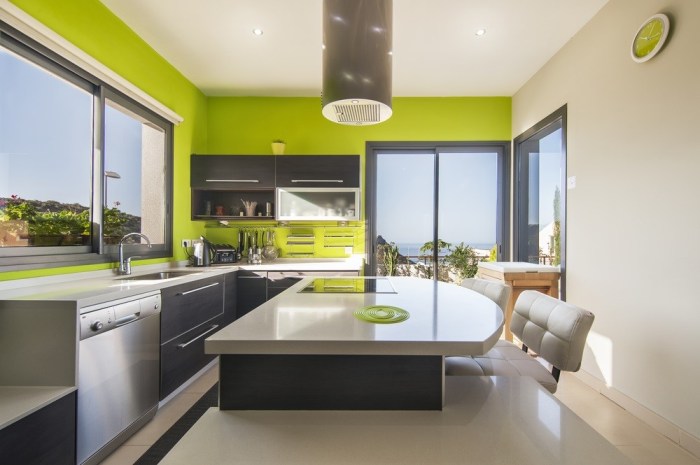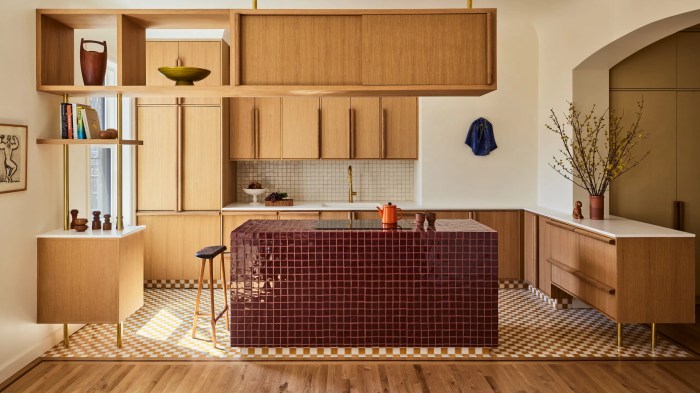The minimalist clean kitchen aesthetic transcends mere design; it’s a philosophy of functionality and serenity. This approach prioritizes essential elements, clean lines, and a carefully curated color palette to create a space that is both visually appealing and highly efficient. We’ll explore the core principles of this style, examining how the strategic use of space, natural materials, and thoughtful storage solutions contribute to a calming and productive culinary environment.
From color palettes and material choices to appliance selection and layout optimization, we’ll delve into the science of creating a kitchen that is both beautiful and highly functional, reflecting the principles of mindful living and efficient design.
This exploration will examine the interplay between form and function, showcasing how minimalist principles can be applied to create a kitchen that is not only aesthetically pleasing but also optimized for ease of use and efficient workflow. We will consider the psychological impact of a clutter-free environment, and how the design choices made can contribute to a sense of calm and well-being.
The journey will involve understanding the scientific basis behind color psychology, material selection, and spatial organization within the context of kitchen design, culminating in a holistic understanding of achieving a minimalist clean kitchen that reflects personal style and practical needs.
Defining Minimalist Clean Kitchen Aesthetics

Minimalist clean kitchen aesthetics represent a design philosophy prioritizing functionality, simplicity, and visual clarity. This approach contrasts sharply with maximalist styles, which embrace abundance and ornamentation. Understanding the core principles of both is crucial for achieving a truly effective and satisfying kitchen design.
Core Principles of Minimalist Kitchen Design
Minimalist kitchen design adheres to the principle of “less is more.” This involves a conscious reduction of visual clutter and unnecessary elements. The focus is on essential items, carefully selected for both their practicality and aesthetic contribution. This approach is rooted in the belief that removing superfluous items enhances functionality and creates a sense of calm and spaciousness, even in smaller kitchens.
The underlying scientific principle at play here is the impact of environmental stimuli on cognitive function. A less cluttered environment reduces cognitive overload, allowing for more efficient task completion and a more relaxed atmosphere.
Key Characteristics of a Clean Kitchen Aesthetic
A clean kitchen aesthetic extends beyond mere tidiness; it’s a deliberate design choice. Key characteristics include a neutral color palette, often featuring white, gray, or beige, to create a sense of openness and airiness. Clean lines and simple geometric shapes are preferred over intricate detailing. Surfaces are kept uncluttered, with appliances and storage solutions seamlessly integrated into the overall design.
The result is a space that feels both inviting and effortlessly organized. This aesthetic aligns with principles of Gestalt psychology, emphasizing the importance of visual organization and simplicity in creating a harmonious and easily comprehensible environment.
Comparison of Minimalist and Maximalist Kitchen Styles
Minimalist and maximalist kitchens represent opposing ends of a design spectrum. Minimalist kitchens prioritize simplicity, functionality, and clean lines, using a limited color palette and minimizing ornamentation. Maximalist kitchens, conversely, embrace abundance, layering textures, colors, and patterns to create a rich and visually stimulating space. A minimalist kitchen might feature a single, sleek pendant light, while a maximalist kitchen could boast a collection of diverse lighting fixtures.
The choice between these styles reflects personal preferences and lifestyle choices. The impact on mood and perception is demonstrably different; minimalist designs often promote feelings of calm and focus, while maximalist designs can evoke excitement and creativity.
Essential Elements for a Minimalist Clean Kitchen
The following table Artikels essential elements for achieving a minimalist clean kitchen. Careful selection of materials and a cohesive design are key to maintaining the desired aesthetic.
| Item | Description | Material Suggestions | Visual Example |
|---|---|---|---|
| Countertops | The primary work surface of the kitchen. | Quartz, marble, stainless steel | A seamless expanse of light-grey quartz, unbroken by seams or excessive detailing. |
| Cabinets | Storage solutions for kitchen essentials. | Solid wood (light colors), matte-finish laminate | Sleek, handleless cabinets in a pale wood finish, extending to the ceiling for maximum storage. |
| Appliances | Essential tools for food preparation and cooking. | Stainless steel, integrated designs | A built-in refrigerator and oven, seamlessly integrated into the cabinetry, maintaining a clean, uncluttered look. |
| Lighting | Provides illumination and ambiance. | Recessed lighting, minimalist pendant lights | A single, large pendant light hanging centrally over the kitchen island, casting a soft, even light. |
Color Palettes and Materials
The selection of color palettes and materials is paramount in achieving the desired minimalist clean aesthetic in a kitchen. These choices directly impact the perceived spaciousness, light reflection, and overall mood of the room. The interplay of color and texture creates a visual harmony that enhances functionality and contributes to a sense of calm and order. Careful consideration of these elements is crucial for a successful minimalist design.
Minimalist Kitchen Color Palettes
Three distinct color palettes, each with a different mood and character, can be effectively employed in a minimalist kitchen. These palettes leverage the principles of color psychology to create specific atmospheres. The hex codes provided allow for precise replication of the chosen shades.
- Palette 1: Cool and Serene (#F2F2F2, #A7C4BC, #5D6D7E): This palette utilizes a light gray (#F2F2F2) as a base, complemented by a soft sage green (#A7C4BC) for accents and a muted blue-gray (#5D6D7E) for subtle contrast. This combination evokes a feeling of tranquility and spaciousness, ideal for smaller kitchens. The cool tones create a sense of calm and order.
- Palette 2: Warm and Inviting (#FAF0E6, #E0B0FF, #D2691E): This palette features a warm off-white (#FAF0E6) as its foundation, accented by a light lavender (#E0B0FF) and a muted burnt orange (#D2691E). This combination creates a welcoming and slightly more vibrant atmosphere, while still maintaining a minimalist feel. The warmth of the palette fosters a sense of comfort and sociability.
- Palette 3: Monochromatic Elegance (#FFFFFF, #F5F5F5, #E5E5E5): This palette employs varying shades of white (#FFFFFF, #F5F5F5, #E5E5E5) to create a sophisticated and sleek aesthetic. The subtle gradations of white add depth without disrupting the minimalist clean lines. This option maximizes light reflection, making the kitchen feel airy and expansive. The simplicity enhances the feeling of cleanliness and modern sophistication.
Natural Materials in Minimalist Kitchens
The incorporation of natural materials such as wood, stone, and concrete significantly enhances the minimalist aesthetic. These materials possess inherent textural qualities that add warmth and visual interest without overwhelming the space. The tactile nature of these materials contributes to a more grounding and sensory experience within the kitchen environment. Furthermore, many natural materials are durable and sustainable, aligning with the values often associated with minimalist design.
Countertop Materials and Aesthetic Impact
Different countertop materials contribute significantly to the overall aesthetic of a minimalist kitchen. The choice reflects both practical considerations and design preferences.
- Quartz: Quartz countertops offer a sleek, modern look with a wide variety of colors and patterns available. Their non-porous nature makes them highly durable and easy to maintain, aligning well with the clean aesthetic of a minimalist kitchen. The uniformity of quartz often contributes to a more streamlined and contemporary feel.
- Butcher Block: Butcher block countertops, made from wood, bring a warm, organic element to the minimalist space. Their natural variations in color and grain create visual interest. However, butcher block requires more maintenance than quartz, needing regular oiling to preserve its condition. The contrast of wood against other materials in the kitchen creates a visually engaging, yet still minimalist, feel.
Backsplash Options for Minimalist Clean Kitchens
The backsplash plays a crucial role in completing the minimalist kitchen design. The choice should complement the overall palette and materials while maintaining a sense of simplicity.
- Large format, neutral-toned tiles (e.g., large white subway tiles or light grey porcelain tiles): These provide a clean, uninterrupted surface that visually expands the space.
- A simple, solid-color painted wall: This creates a seamless and uncluttered backdrop, allowing other elements in the kitchen to stand out.
- Thin, horizontal metal strips: These offer a subtle textural contrast and a touch of industrial chic without being overwhelming.
- Natural stone slabs (e.g., marble or slate): These can add a luxurious and sophisticated touch, especially when paired with natural wood elements.
Storage and Organization Solutions

Maximizing space and maintaining visual order are paramount in a minimalist kitchen. Efficient storage solutions are not merely aesthetic choices; they are integral to the functionality and serenity of this design philosophy. The principles of minimalism, rooted in intentional living and the rejection of clutter, necessitate a strategic approach to storage that prioritizes both practicality and visual harmony.Effective storage hinges on understanding the principles of spatial optimization and the efficient use of available resources.
This involves leveraging vertical space, utilizing hidden storage, and employing smart organizational techniques to keep frequently used items easily accessible while maintaining a clean and uncluttered aesthetic. The following strategies, grounded in ergonomic principles and design best practices, exemplify this approach.
Practical Storage Solutions for Maximizing Space
Minimalist kitchens often feature a limited amount of counter and cabinet space. Therefore, maximizing storage requires a multi-pronged approach that considers both visible and hidden storage options. This includes the strategic use of drawer organizers, pull-out shelves, and vertical storage solutions to make the most of every available inch. Furthermore, employing space-saving techniques such as stackable containers and slimline storage solutions contributes to the overall efficiency of the kitchen’s storage capacity.
The selection of these items should prioritize functionality and aesthetic harmony to maintain the minimalist aesthetic.
Smart Storage Ideas for Frequently Used Kitchen Items
Prioritizing accessibility for frequently used items is crucial for efficient workflow and reduces the likelihood of clutter. A well-organized minimalist kitchen places these items within easy reach, minimizing unnecessary searching and movement.
- Utensil Drawers: Employing drawer dividers to neatly organize utensils, keeping them separated and readily accessible.
- Spice Racks: Utilizing a wall-mounted spice rack or a carousel spice rack for efficient organization and visibility.
- Countertop Organization: Restricting countertop items to a select few essential tools, such as a coffee maker, a fruit bowl, and a small cutting board.
- Pegboard System: Installing a pegboard on a wall to hang frequently used tools and small appliances, creating a visually appealing and organized display.
Utilizing Vertical Space Effectively
Vertical space, often underutilized, presents a significant opportunity for increased storage capacity in a minimalist kitchen. By employing tall, narrow cabinets, extending shelving units to the ceiling, and incorporating pull-out pantry systems, significant storage gains can be achieved. This strategy maximizes storage without sacrificing valuable floor space, adhering to the core tenets of minimalist design. For example, a kitchen with 8-foot ceilings could potentially double its storage capacity by utilizing vertical space effectively compared to a design that only utilizes lower cabinets.
Visual Description of a Well-Organized Pantry
Imagine a pantry with sleek, white shelving units extending from floor to ceiling. Each shelf is lined with uniformly sized, clear glass or white containers, neatly labeled with minimalist black lettering. Dry goods such as pasta, rice, and grains are stored in airtight containers to maintain freshness and prevent pests. Spices are housed in a separate section, organized alphabetically or by culinary use, easily accessible for quick identification.
The overall impression is one of clean lines, uncluttered space, and a sense of calm order. The use of consistent containers and clear labeling further enhances the visual appeal and contributes to the overall minimalist aesthetic. This well-organized pantry exemplifies efficient storage while maintaining the clean lines characteristic of a minimalist kitchen.
Appliance and Fixture Selection

The minimalist kitchen prioritizes functionality and clean lines, extending this philosophy to the selection of appliances and fixtures. Careful consideration of both aesthetic appeal and practical performance is crucial in achieving a cohesive and efficient space. The wrong choices can quickly disrupt the carefully curated minimalism, introducing visual clutter and compromising usability.Appliance selection in a minimalist kitchen hinges on integrating seamlessly with the overall design.
The emphasis should be on streamlined models with hidden controls and minimal branding. The physical footprint of appliances should be carefully considered to optimize space and avoid overwhelming the visual field.
Suitable Appliance Choices
The ideal appliances for a minimalist kitchen are characterized by their sleek, integrated designs and high-efficiency performance. Built-in ovens and microwaves, for example, maintain a unified aesthetic by being seamlessly incorporated into cabinetry. Induction cooktops offer a clean, flat surface, unlike traditional gas or electric ranges, which often exhibit more pronounced visual elements. Refrigerators with integrated handles and minimalist paneling blend seamlessly into the cabinetry, minimizing visual disruption.
Dishwashers, similarly, should be chosen for their unobtrusive design, often featuring a handleless design or recessed handles. The selection of stainless steel appliances can provide a unified and modern aesthetic, but only if consistent across all appliances.
Sleek and Functional Kitchen Fixtures
Kitchen fixtures, including faucets, lighting, and hardware, play a pivotal role in establishing the minimalist aesthetic. Sleek, single-lever faucets, for instance, provide both functionality and a visually uncluttered appearance. Their minimalist design contributes to the overall clean lines of the kitchen. Similarly, under-cabinet lighting, recessed lighting, or pendant lights with simple, geometric designs maintain a sense of spaciousness and avoid visual clutter.
Cabinet hardware should be chosen for its simplicity – minimalistic knobs or recessed handles contribute to the uncluttered look. The selection of matte black, brushed nickel, or polished chrome fixtures can create a cohesive and sophisticated look, depending on the overall color palette.
Kitchen Lighting Styles for Minimalist Design
Different lighting styles contribute varying effects to the minimalist kitchen aesthetic. Recessed lighting provides even illumination across the entire space, emphasizing the clean lines and creating a sense of spaciousness. Under-cabinet lighting, on the other hand, offers task lighting for food preparation areas without adding visual bulk. Pendant lights, when strategically placed, can serve as both ambient and accent lighting, but their design should be simple and geometric to maintain the minimalist feel.
Avoid overly ornate or elaborate fixtures; the goal is to provide functional illumination without visual distractions. Consider the use of LED lighting for its energy efficiency and consistent light output.
Minimalist Kitchen Layout: A Case Study
Consider a 10ft x 12ft kitchen layout. A galley-style kitchen is well-suited for a minimalist approach. Along one 10ft wall, place a 3ft wide refrigerator integrated into the cabinetry, followed by a 3ft wide, handleless dishwasher, and a 4ft long, built-in oven and microwave combination. The opposite 10ft wall features a 6ft long induction cooktop with a simple, integrated extractor hood above, and a 4ft long countertop for food preparation, ending with a small 2ft wide sink with a sleek, single-lever faucet.
The remaining space can be used for storage and open shelving. This layout prioritizes functionality while maintaining a clean, uncluttered aesthetic. All appliances are integrated, minimizing visual clutter and maximizing space efficiency.
Illustrative Examples of Minimalist Clean Kitchens

Minimalist clean kitchen design prioritizes functionality, simplicity, and a sense of calm. Achieving this involves careful consideration of color palettes, materials, lighting, and spatial organization. The following examples showcase diverse interpretations of this aesthetic, each demonstrating how different approaches can create unique and inviting spaces.
Example 1: The Scandinavian Minimalist Kitchen
This design embodies the core principles of Scandinavian design: functionality, simplicity, and natural light. The color palette is predominantly white and light gray, accented with natural wood tones. Materials include light oak cabinetry, a white quartz countertop, and a matte white subway tile backsplash. The layout is typically linear or L-shaped, maximizing space efficiency. Lighting plays a crucial role; large windows provide ample natural light, supplemented by recessed LED lighting for task illumination and pendant lights over the island, creating a warm and inviting atmosphere.
The overall mood is bright, airy, and serene, promoting a sense of calm and relaxation. Functionality is optimized through clever storage solutions, such as built-in drawers and pull-out pantry shelves. The clean lines and neutral color scheme create a feeling of spaciousness, even in smaller kitchens.
Example 2: The Industrial Minimalist Kitchen
This style contrasts the softness of the Scandinavian approach with a more industrial aesthetic. The color palette features a combination of dark gray or black cabinetry, complemented by stainless steel appliances and concrete or polished concrete flooring. Materials include raw concrete countertops, metal accents, and dark wood elements. The layout is often open-plan, integrating the kitchen seamlessly into the living space.
Lighting is key; track lighting highlights specific areas, while strategically placed pendant lights over the island provide focused illumination. The overall mood is sophisticated, edgy, and functional, creating a space that is both stylish and practical. Functionality is maximized through efficient use of space and robust, durable materials. The industrial elements add a touch of raw texture and character, balancing the minimalist aesthetic with a sense of urban coolness.
Example 3: The Japanese Minimalist Kitchen
Inspired by Japanese design principles, this kitchen emphasizes simplicity, order, and a connection to nature. The color palette is muted and natural, often featuring shades of beige, white, and light wood. Materials include light-colored wood cabinetry, a pale stone countertop, and a neutral-toned backsplash. The layout is typically clean and uncluttered, often incorporating a minimalist island. Lighting is soft and diffused, using a combination of natural light and recessed lighting to avoid harsh shadows.
The overall mood is calm, peaceful, and serene, reflecting the principles of Japanese aesthetics. Functionality is achieved through meticulous organization and the use of space-saving storage solutions. The minimalist design creates a sense of tranquility and harmony, fostering a sense of mindfulness and calm during food preparation.
Ending Remarks
Ultimately, the minimalist clean kitchen represents more than just a trend; it’s a testament to the power of intentional design. By carefully selecting materials, optimizing storage, and embracing a streamlined aesthetic, we can create a space that fosters both creativity and relaxation. The journey towards achieving this ideal involves understanding the principles of minimalism, embracing natural materials, and prioritizing functionality.
The result is a kitchen that is not only visually stunning but also a sanctuary of calm and efficiency, a space where culinary creativity thrives amidst a backdrop of serene simplicity. The principles explored here can be adapted to various kitchen sizes and layouts, ensuring that the essence of minimalist design can be incorporated into any home.
Detailed FAQs
What are the biggest mistakes people make when designing a minimalist kitchen?
Overlooking sufficient storage, neglecting proper lighting, and choosing impractical materials are common pitfalls. A well-planned minimalist kitchen requires careful consideration of these aspects.
How can I incorporate sustainability into my minimalist kitchen design?
Choose recycled or reclaimed materials, opt for energy-efficient appliances, and select durable, long-lasting items to minimize waste and environmental impact. Consider bamboo cutting boards or reclaimed wood countertops.
What about incorporating personal touches in a minimalist setting?
Minimalism isn’t about sterility; it’s about intentionality. A few carefully chosen, meaningful items – a cherished family recipe book, a piece of art – can add personality without compromising the overall aesthetic.
How do I maintain a minimalist kitchen long-term?
Regular decluttering, consistent cleaning, and mindful purchasing are key. Develop a system for organizing and storing items, and stick to it. The key is to avoid accumulating unnecessary items.
Can I achieve a minimalist kitchen on a budget?
Absolutely. Prioritize functionality over expensive finishes. Repurpose existing items, shop secondhand for appliances and furniture, and focus on creating a cohesive design with cost-effective materials.